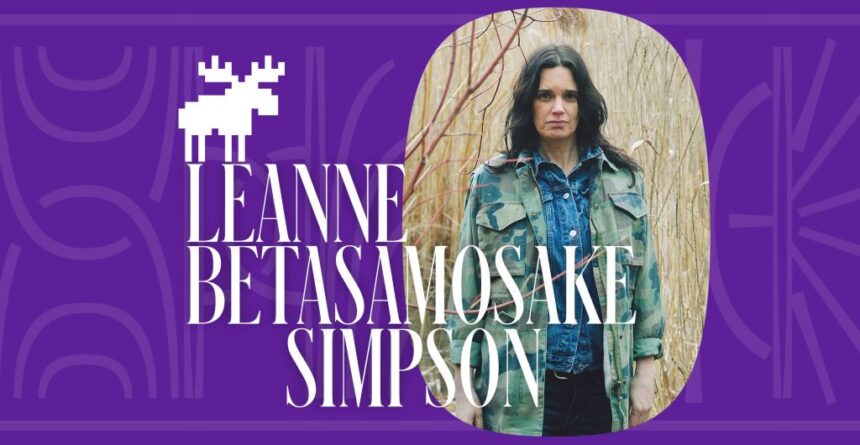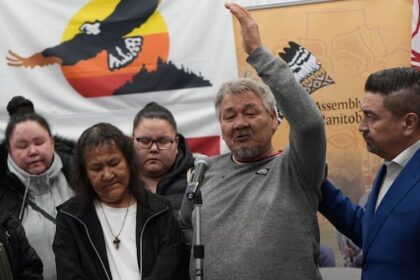Like most of us, Leanne Betasamosake Simpson drinks water every day. It’s an ordinary act. But the Michi Saagiig Nishnaabeg scholar, writer and artist says it’s also a deep expression of our connection to the natural world. In recent years, Simpson has come to see her body as a node that “connects, through water, to every other living being and every other group of people on the planet,” she said during an interview with Métis artist Christi Belcourt at the Toronto Reference Library in April, adding that “our women have been walking around lakes and bringing attention to water for years and years and years.” The intuition that water is a connective force has grounded Simpson’s recent work, from her 2021 record Theory of Ice, which was shortlisted for the Polaris Music Prize, to her latest book, Theory of Water: Nishnaabe Maps to the Times Ahead. In that book, Simpson listens to and learns from water as she imagines a world beyond the myriad social injustices of our time. She draws on her deep familiarity with Nishnaabe knowledge and lifeways — learned in part through a decades-long apprenticeship with Doug Williams, an Elder from Curve Lake First Nation near Peterborough, Ont. — and brings it to bear on our shared contemporary moment. Simpson has a PhD in Interdisciplinary Studies from the University of Manitoba, and adds her latest record, Live Like the Sky — released this Friday, Oct. 24 — to a long list of artistic accomplishments. As Simpson awaited the album’s release, she took a moment to answer The Narwhal’s Moose Questionnaire. Here’s what she had to say about land-based learning, making awe a regular practice and the items in her “emotional support backpack.” This interview has been edited and condensed for length and clarity. All opinions are the subject’s own. Illustration: Shawn Parkinson / The Narwhal What’s the most awe-inspiring natural sight you’ve witnessed between the Pacific, Atlantic, 49th parallel and Hudson Bay, i.e. Canada? This is a dorky answer but the most awe-inspiring natural sight I’ve witnessed is mino bimaadiziwin — the continuous rebirth and reproduction of life on our shared planet. The ecological network that reproduces life. The water cycle. The moon. The spiritual and material strains that connect us. Our only responsibility is to live within that system and bring forth more life. Not just human life, but all life. For me the trick is to find awe and inspiration in every piece of the natural world and in every Indigenous homeland and body of water, regardless of how much harm they carry from extraction, neglect and exploitation. Also monarch butterflies. The whole “being soup in a tiny sleeping bag hanging on a milkweed plant to rebuild yourself into the most fragile weird flying saucer thing that travels en masse to Mexico, and knows how to wing your way across Lake Ontario as a warm-up.” Like come on, do that humans. Also I was at the Mnoominkewin Festival at Curve Lake First Nation in September celebrating wild rice. I was down on the shore of Chemong Lake and a large group of participants were in canoes planting seeds in a growing rice bed. That was a tremendous thing to witness. The wild rice on that lake used to be so thick the lake looked like a prairie. That was all destroyed by the Trent Severn Waterway, cottage development and pesticides, so to see this resurgence of a cherished Nishnaabeg way of caring for our community was pretty wonderful. The return of wild rice in Michi Saagiig territory is “a tremendous thing to witness,” Leanne Betasamosake Simpson says. Photo: Vanessa Tignanelli / The Narwhal What’s the most awe-inspiring natural sight you’ve witnessed outside of Canada? The Sakiya project is a land-based education project in the West Bank in Palestine, whose vision is: “Liberation through a society whose confidence is rooted in traditional and contemporary ecological practices, whose tolerance echoes nature’s diversity, whose generosity springs from collective labour, whose creativity is enriched by the intersections between art, science and agriculture and whose prosperity is shared beyond boundaries.” I visited the centre during the Palestine Festival of Literature in 2023 and really loved to see all the ways they were deepening their connection to their homeland, to cultural production and creative practice and to sharing that knowledge. Think of three iconic Canadian animals. Choose one each to kiss, marry and kill. I’d put tobacco down and ask a moose to give up its life for me, so that I could share the meat, bones, hide and nose with people in our communities. One moose can nourish a lot of people. I’d live in sin with a beaver. Their orange chisel-like incisors! Their nictitating membrane! Nishnaabeg people have a story of someone who married a beaver and we gained a tremendous insight into how to live with beavers as a result. I’d kiss a lynx, entirely because I think the shyness and reluctance on both of our parts would make consent and the actual kiss next to impossible to pull off. Outdoor cats: yes or no? All the power to lynxes, bobcats, mountain lions and cougars. Name one person who could significantly help mitigate the climate crisis if they really wanted to. All the fascists, elected officials, genocide deniers, billionaires and tech bros. And all of us. If each one of us found three people and organized to make something in our local communities better, we would be making a different future. Rocky Mountains or Great Lakes? The Great Lakes made me. Lake Ontario is a defining feature of Leanne Betasamosake Simpson’s territory. “The Great Lakes made me,” the scholar and artist says. Photo: Christopher Katsarov Luna / The Narwhal Researchers at Yale University, the France-based Women’s Forum for the Economy and Society and other institutions have found women tend to be more concerned about climate change than men. Why do you think that is? This is another dorky answer. I turned off the robots and looked up the actual study, and read it because I highly recommend critical thought. This study is dated. It focused on men and women in the United States. It conforms to a colonial gender binary and erases queer and gender fluid identities. It seems to not account for other factors like race, education level and socio-economic factors. The study does clock a change in 2010. Apparently, prior to 2010, men and women had a similar knowledge of climate change and then it shifted, and the study suggests women in the U.S. are less likely than men to know certain scientific facts about climate change. This is another red flag to me because it’s conforming to the Barbie-is-bad-at-math kind of misogyny. We also know that in our present moment, climate deniers, genocide deniers, science deniers, MAGA people and the right target and recruit young white men and that they were successful in getting Trump elected. That’s the issue we should be studying and organizing against. In Indigenous communities all genders are concerned about climate change because our ancestors saw it was going to be a huge problem once settlers set foot on Turtle Island, disregarded our sovereignties, laws and ethical practices and imposed colonialism and capitalism on us. Sorry, I went all professor there. If you could dip a toe off Canada’s coastline, which ocean would it be in? I’m wishing for the empty Pacific. Leanne Betasamosake Simpson (fifth from right) spends a lot of time in the North teaching Indigenous youth, including through hide-tanning courses such as this one. Photo: Sandy Gordon What’s a beautiful or useful thing you’ve owned for a really long time? I’m on the road a lot and so my backpack is actually an emotional support backpack, jammed with everything from portable chargers to nail clippers to tea bags to a portable espresso maker. One time my emotional support backpack broke in the Vancouver airport and the 4,000 items in it were spilling out as I was running for a connecting flight. I ended up having to buy a large tote bag which my kids call “the millennial mom bag,” even though it’s pretty obvious from this answer I’m generation X. What’s the farthest north you’ve ever been and what did you do there? I spent a lot of time in the North teaching in Denendeh, Kaska Dena territory and Inuvik, which is part of Gwichi’in and Inuvialuit homelands, for the Dechinta Centre of Research and Learning, which is based in Yellowknife. It’s an Indigenous-led, land-based post-secondary education program. We take Elders, students and their children out on the land to learn from and with the land in a multi-generational Indigenous context. The students spend part of the day learning from Elders and part of the day learning from people like me, and they can earn Indigenous Studies credits from the University of British Columbia. We provide childcare, meals, accommodation and all kinds of academic and wellness support to ensure that we are channelling resources into northern Indigenous communities and to make sure our programming is meaningful to people of all genders and sexual orientations. I’ve also done writing workshops in Sapmi (northern Finland, Sweden and Norway). I think the farthest north I’ve been is Tuktoyaktuk in Inuvialuit territory but it might be Igloolik in Nunavut. This year I helped teach hide-tanning courses in Inuvik with Montana and Delaney Prynuk. It was pretty amazing tanning hides near the former sites of residential schools. What’s one way you interact with the natural world on a daily basis? I drink water. Every day. Yes, you have to choose: smoked salmon or maple syrup? Maple smoked salmon. Would you rather be invited to visit David and Victoria Beckham at their Muskoka, Ont., cottage, or Harry and Meghan Sussex at their B.C. oceanic escape? No. Camping: yes or no? Yes. Enjoying the Moose Questionnaire? Read more from the series here. Recent Posts ‘The Great Lakes made me,’ says scholar, poet and musician Leanne Betasamosake Simpson Oct. 21, 2025 8 min. read The member of Alderville First Nation shares her thoughts on water and life — and what… B.C. bets big changes to energy policy will reap massive rewards Oct. 20, 2025 7 min. read The province says Bill 31 will speed up construction of the $6-billion North Coast transmission… How plans for a sprawling subdivision near Ottawa’s Greenbelt are dividing the city Oct. 20, 2025 15 min. read The Tewin housing megaproject, backed by major developer Taggart Group, has city councillors and residents…
The Great Lakes made me, says scholar, poet and musician Leanne Betasamosake Simpson












